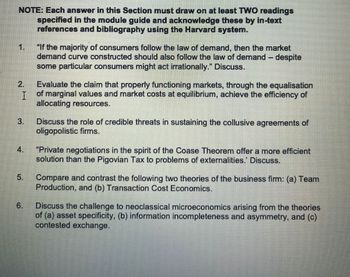
ENGR.ECONOMIC ANALYSIS
14th Edition
ISBN: 9780190931919
Author: NEWNAN
Publisher: Oxford University Press
expand_more
expand_more
format_list_bulleted
Question
part 3 and 4 needed

Transcribed Image Text:NOTE: Each answer in this Section must draw on at least TWO readings
specified in the module guide and acknowledge these by in-text
references and bibliography using the Harvard system.
1.
3.
6
"If the majority of consumers follow the law of demand, then the market
demand curve constructed should also follow the law of demand - despite
some particular consumers might act irrationally." Discuss.
Evaluate the claim that properly functioning markets, through the equalisation
I of marginal values and market costs at equilibrium, achieve the efficiency of
allocating resources.
Discuss the role of credible threats in sustaining the collusive agreements of
oligopolistic firms.
"Private negotiations in the spirit of the Coase Theorem offer a more efficient
solution than the Pigovian Tax to problems of externalities.' Discuss.
Compare and contrast the following two theories of the business firm: (a) Team
Production, and (b) Transaction Cost Economics.
Discuss the challenge to neoclassical microeconomics arising from the theories
of (a) asset specificity, (b) information incompleteness and asymmetry, and (c)
contested exchange.
Expert Solution
This question has been solved!
Explore an expertly crafted, step-by-step solution for a thorough understanding of key concepts.
Step by stepSolved in 3 steps

Knowledge Booster
Learn more about
Need a deep-dive on the concept behind this application? Look no further. Learn more about this topic, economics and related others by exploring similar questions and additional content below.Similar questions
- 8 Write an email (120-150 words) to ask for • information about an activity that you would like to do. Use an idea from the list or your own idea. Follow the content checklist and remember to use indirect questions. a course at a college or with a one-to-one tutor a sport / activity at a gym joining a volunteering group Checklist • how you heard about the course / activity/group ⚫ the days and times ⚫ the cost if you need any experience / skills • if you need any equipmentarrow_forwardImagine you are the mayor of a town and you are trying to decide if you should pay for a fireworks show. Your staff survey your 400 citizens who say that they each value a fireworks show at $10. The fireworks show only costs $3,000 so you put on the show but when you ask for donations to pay for the fireworks you only receive $25 total. What does this result show? Select an answer and submit. For keyboard navigation, use the up/down arrow keys to select an answer. You staff's survey must have overestimated the value of a fireworks show. b The fireworks cost must have been greater than their economic benefit. The firework show suffered from the Tragedy of the Commons problems d The town's citizens were free-riders.arrow_forwardWhat are somethings that are abundant in a communityarrow_forward
- Name the three general categories of Resourcesarrow_forwardThe first step to take when you consider making a major purchase is to decide (a) whether you need the product (b) whether you have enough money to buy the product (c) what make and model of the product you should buy (d) where the best place is to purchase the product.arrow_forwardblanks C and D?arrow_forward
arrow_back_ios
arrow_forward_ios
Recommended textbooks for you

 Principles of Economics (12th Edition)EconomicsISBN:9780134078779Author:Karl E. Case, Ray C. Fair, Sharon E. OsterPublisher:PEARSON
Principles of Economics (12th Edition)EconomicsISBN:9780134078779Author:Karl E. Case, Ray C. Fair, Sharon E. OsterPublisher:PEARSON Engineering Economy (17th Edition)EconomicsISBN:9780134870069Author:William G. Sullivan, Elin M. Wicks, C. Patrick KoellingPublisher:PEARSON
Engineering Economy (17th Edition)EconomicsISBN:9780134870069Author:William G. Sullivan, Elin M. Wicks, C. Patrick KoellingPublisher:PEARSON Principles of Economics (MindTap Course List)EconomicsISBN:9781305585126Author:N. Gregory MankiwPublisher:Cengage Learning
Principles of Economics (MindTap Course List)EconomicsISBN:9781305585126Author:N. Gregory MankiwPublisher:Cengage Learning Managerial Economics: A Problem Solving ApproachEconomicsISBN:9781337106665Author:Luke M. Froeb, Brian T. McCann, Michael R. Ward, Mike ShorPublisher:Cengage Learning
Managerial Economics: A Problem Solving ApproachEconomicsISBN:9781337106665Author:Luke M. Froeb, Brian T. McCann, Michael R. Ward, Mike ShorPublisher:Cengage Learning Managerial Economics & Business Strategy (Mcgraw-...EconomicsISBN:9781259290619Author:Michael Baye, Jeff PrincePublisher:McGraw-Hill Education
Managerial Economics & Business Strategy (Mcgraw-...EconomicsISBN:9781259290619Author:Michael Baye, Jeff PrincePublisher:McGraw-Hill Education


Principles of Economics (12th Edition)
Economics
ISBN:9780134078779
Author:Karl E. Case, Ray C. Fair, Sharon E. Oster
Publisher:PEARSON

Engineering Economy (17th Edition)
Economics
ISBN:9780134870069
Author:William G. Sullivan, Elin M. Wicks, C. Patrick Koelling
Publisher:PEARSON

Principles of Economics (MindTap Course List)
Economics
ISBN:9781305585126
Author:N. Gregory Mankiw
Publisher:Cengage Learning

Managerial Economics: A Problem Solving Approach
Economics
ISBN:9781337106665
Author:Luke M. Froeb, Brian T. McCann, Michael R. Ward, Mike Shor
Publisher:Cengage Learning

Managerial Economics & Business Strategy (Mcgraw-...
Economics
ISBN:9781259290619
Author:Michael Baye, Jeff Prince
Publisher:McGraw-Hill Education